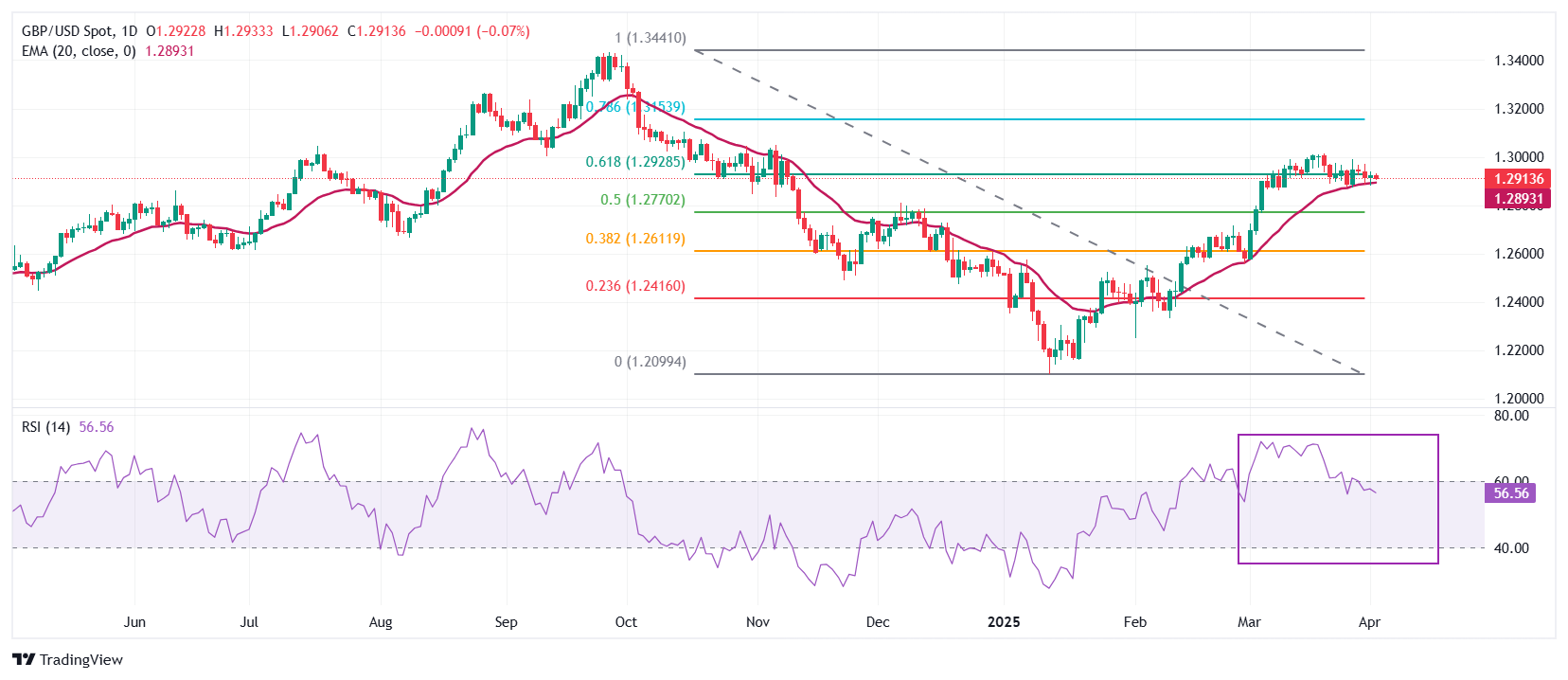- The sterling pound is quoted in a narrow range around 1,2900 against the US dollar, since the US president, Trump, is scheduled to present the reciprocal tariff plan.
- The Trump tariff agenda is expected to address unfair practices by its commercial partners.
- The decrease in the impulse of salary growth in the United Kingdom could pave the way for more interest rate cuts by the BOE.
The sterling pound (GBP) is quoted laterally around 1,2900 against the US dollar (USD) in the European session on Wednesday. The GBP/USD torque is consolidated while investors remain on the sidelines, waiting for the publication of a detailed plan for reciprocal tariffs by the president of the United States (USA), Donald Trump, later in the day.
The president of the USA, Trump, has been promoting April 2 as the “Day of Liberation” for weeks, since he believes that the imposition of reciprocal tariffs will make “America great again.” The reciprocal tariffs of Trump are expected to soon alter the global commercial system, since the White House spokeswoman, Karoline Leavitt, said the new levies will come into effect immediately after the announcement.
The feeling of the market is expected to become excessively adverse to risk if the degree of import tariffs turns out to be higher than expected. A Washington Post note on Tuesday showed that the White House advisors have written a proposal to impose 20% tariffs on most imports to the USA. In addition, the US Treasury Secretary of the US Treasury, Scott Besent, said Tuesday that the president will impose the highest gravates possible to his main commercial allies. Besent suggested that tariffs on the target countries could decrease if they reduce commercial and non -commercial barriers for US imports.
Donald Trump is expected to distribute household tariffs through fiscal dividends or reimbursements. Such scenario will be inflationary for the US economy, forcing the Federal Reserve (FED) to maintain a restrictive monetary policy position in the short term.
In Wednesday’s session, investors will also focus on ADP employment change data for March, which will be published at 12:15 GMT. The agency is expected to show that private employers added new workers, more than the 77K added in February.
What moves the market today: the pound sterling quotes cautiously to the nerves for Trump’s tariffs
- The sterling pound is quietly in front of its main peers on Wednesday. The British currency fights while investors become adverse to risk before Trump’s reciprocal tariffs. Market participants hope that the new series of Trump taxes despite global economic growth, assuming that the imposition of higher tariffs by the United States to its commercial partners will make their products less competitive in the global market.
- The economy of the United Kingdom (UK) will also support the burden of uncertainty in the global market. The United Kingdom Business Responsibility Office (OBR) warned Monday that Trump’s policies could eliminate the government’s fiscal mattress and reduce the size of the economy by up to 1%.
- In addition, a delay in negotiations between the US and the United Kingdom on the end of an economic agreement beyond the “Day of Liberation” has also generated concerns about the perspectives of commercial relations between them. There is a high probability that the terms and conditions of the possible economic agreement change after the announcement of reciprocal tariffs.
- Meanwhile, the decrease in salary growth pressures is expected to raise the dovish bets of the Bank of England (BOE). Income data research (IDR) on Wednesday that the average salary increase grew 3.5% in the three months until February, slower than 4% of the previous publication. This was the lowest level seen in three years. It seems that employers refrain from granting significant increases to compensate for the increase in contributions to social security schemes. In the Autumn Declaration, the Treasury Chancellor Rachel Reeves, increased the contribution of employers to the National Insurance (NI) from 13.8% to 15%.
Technical analysis: The sterling pound moves around 1,2900 against the US dollar
The sterling pound is traded within Tuesday’s negotiation range against the US dollar on Wednesday. The GBP/USD pair continues to oscillate around the 61.8%fibonacci setback, drawn from the maximum of September to the minimum of mid -January, about 1,2930. The 20 -day exponential (EMA) mobile average provides a support to the torque around 1,2890.
The 14 -day relative force index (RSI) cools about 60.00 after having been overcomplicated above 70.00. A new bullish impulse should arise if the RSI resumes its ascending trajectory after staying above the 60.00 level.
Looking down, the 50% fibonacci setback in 1,2770 and the 38.2% fibonacci setback in 1,2615 will act as key support areas for the torque. On the positive side, the maximum of October 15, 1,3100 will act as a key resistance zone.
LIBRA ESTERLINA FAQS
The sterling pound (GBP) is the oldest currency in the world (886 AD) and the official currency of the United Kingdom. It is the fourth most commercialized currency exchange unit (FX) in the world, representing 12% of all transactions, with an average of $ 630 billion a day, according to data from 2022. Its key commercial peers are GBP/USD, which represents 11% of FX, GBP/JPY (3%) and EUR/GBP (2%). The sterling pound is issued by the Bank of England (BOE).
The most important factor that influences the value of sterling pound is the monetary policy decided by the Bank of England. The Bank of England bases its decisions itself has achieved its main objective of “price stability”: a constant inflation rate of around 2%. Its main tool to achieve this is the adjustment of interest rates. When inflation is too high, the Bank of England will try to control it by raising interest rates, which makes access to credit for people and companies more expensive. This is generally positive for sterling pound, since higher interest rates make the United Kingdom a more attractive place for global investors to invest their money. When inflation falls too much it is a sign that economic growth is slowing down. In this scenario, the Bank of England will consider lowering interest rates to reduce credit, so that companies will borrow more to invest in projects that generate growth.
Published data measure the health of the economy and can affect the value of sterling pound. Indicators such as GDP, manufacturing and services PMI and employment can influence the direction of the sterling pound.
Another important fact that is published and affects the pound sterling is the commercial balance. This indicator measures the difference between what a country earns with its exports and what you spend on imports during a given period. If a country produces highly demanded export products, its currency will benefit exclusively from the additional demand created by foreign buyers seeking to buy those goods. Therefore, a positive net trade balance strengthens a currency and vice versa in the case of a negative balance
Source: Fx Street
I am Joshua Winder, a senior-level journalist and editor at World Stock Market. I specialize in covering news related to the stock market and economic trends. With more than 8 years of experience in this field, I have become an expert in financial reporting.








